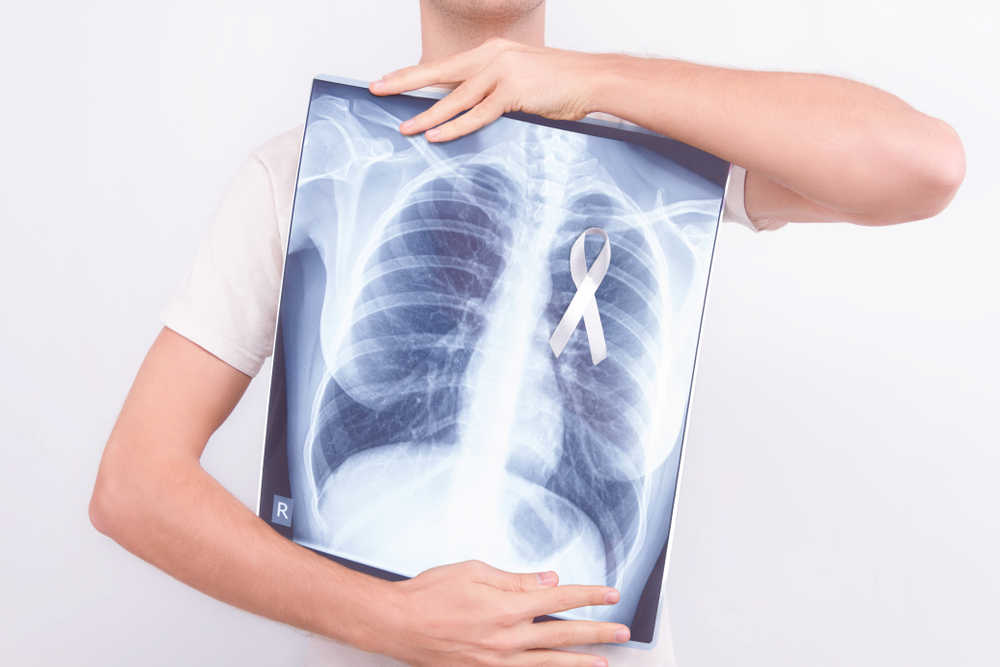Lung cancer is a cancer that begin in the lungs, one of our body’s most fragile organs. Located in the chest, these spongy organs work to provide oxygen to our body. Cancer in the lungs usually begins with a tumor, a group of cells that grow and destroy nearby tissue. While it’s possible the cancer can spread to other parts of the body, when it begins in the lungs it’s called primary lung cancer.
According to the Mayo Clinic, lung cancer is the leading cause of cancer death in the United States. Even though lung cancer kills approximately 1.3 million people each year, the disease is not a definite death sentence. Those diagnosed early stand a 50-percent greater chance of survival over those whose undiagnosed cancer spreads to other organs throughout the body. To better protect yourself against lung cancer, get informed on the following early warning signs…
1. Labored Breathing
Being short of breath after climbing some stairs or doing any kind of mild exercise might not seem like a big deal and is often chalked up to poor exercise habits, but it can be due to something more serious. If you suddenly find yourself short of breath when performing activities that didn’t previously make you winded, you should interpret it as a warning sign that something might be wrong.
Keep in mind that shortness of breath can have many causes, but if you’re at increased risk for lung cancer, you should have it checked out as soon as possible. As noted, cancer survival rates are much higher in cases where the disease is detected early and treated aggressively.
2. Stubborn Cough
A persistent cough that just won’t go away could indicate a lung issue. Sadly, many folks blame this symptom on a cold or allergies and don’t get it checked out. Coughs associated with lung cancer may be dry, or they may be productive. The telltale sign is that it persists for longer than eight weeks with no other apparent cause.
While this type of cough is usually present throughout the day, many patients report that it is worse at night, causing them to lose sleep and leading to fatigue and loss of productivity. Many people dismiss the severity of the symptom, which can unfortunately lead to slower cancer detection.
In addition to having a stubborn cough that just won’t quit, pay attention to what that cough sounds like. This is especially important for smokers. Healthline advises keeping a close watch on how much you’re coughing, what it sounds like, and whether or not you’re coughing up blood or an unusual amount of mucus, particularly any rust-colored phlegm. If so, make an appointment to go see a doctor.
3. Plummeting Weight
Weight loss is often celebrated, but if you’re not cutting calories or exercising more to lose weight, something else might be up. Add to that a sudden lack of appetite and a cancer tumor may be the cause in your sudden metabolism spike. This happens because while you may not detect a problem, your body does, and it’s working harder and expending more calories to try to heal a tumor that keeps growing and growing.
Cancer-related weight loss is usually unexplained, occurring when patients have made no significant changes to their dietary or exercise habits. This condition is technically known as cachexia, and in extreme cases, it can cause the body to literally waste away as it eats away muscle and body fat in its search for all possible sources of energy.
4. Chest Pain
One prime symptom of lung cancer is chest pain that’s felt deep in the lungs when you lift something, cough or laugh, and persistent pain in the chest that doesn’t go away is a sign that you may have lung cancer. This pain occurs because the growing tumor is pressing against surrounding tissues and nerve endings as it increases in size.
If the lung cancer spreads to other parts of the body, these areas are also likely to be affected by pain. Lung cancer metastasis frequently occurs in bones, so if you’re experiencing bone pain, particularly in the back or hips, along with chest pain, see your doctor right away.
5. Hand and Finger Pain
Fatigue and pain in fingers may be two early warning signs of lung cancer that tend to be overlooked. In the majority of cases, when the skin of the palms thickens and becomes white with pronounced folds (a condition called “tripe palms” due to the appearance), cancer is present. Tripe palms are associated with both stomach cancer (35-percent of cases) and lung cancer (11-percent of cases).
This disfiguring symptom is caused by cancer changes to normal bodily processes. In the case of tripe palms, the palmar skin cells are hyper-stimulated, causing them to proliferate and resulting in the buildup of thick, scaly white skin.
6. Bloody Phlegm
Coughing up blood in phlegm is never healthy, even when it’s just tiny spots of rust-colored blood in your phlegm. Even if this doesn’t indicate lung cancer, it likely signals another serious underlying medical condition, and you should have it checked out by a doctor.
In many cases, coughing up blood is accompanied by other symptoms, including shortness of breath, persistent fever, or pain in the chest. As a general rule of thumb, make a doctor’s appointment if you detect small amounts of blood in your phlegm, but seek immediate medical attention if you cough up a large volume of blood or if the bleeding doesn’t stop.
7. Mood Swings
Mood swings, episodes of anger and irritability, followed by exhaustion and even depression can become routine for those suffering from lung cancer. The situation could be most evident in a formerly easygoing person who suddenly seems to let everything irk them. However, given the nonspecific nature of this symptom, most patients (and even doctors) won’t immediately link it with lung cancer.
These mood disturbances are most often associated with advanced-stage lung cancer, so they are unlikely to be the only detectable symptom. However, they can also occur while the cancer is still at a relatively early stage, so if changes in mood accompany any of the other symptoms on this list, a trip to your doctor is a must.
8. Frequent Infections
Recurring pneumonia or bronchitis as well as other infections that one just can’t seem to shake are common with lung cancer, particularly with infections that affect the airways. If you suffer from chronic lung infections, it may be time for a lung x-ray. These infections usually occur because the body’s immune system is compromised by its unrelenting fight against the malignancy.
Oncologists stress that recurrent infections are a normal part of the course of cancer, and they accompany virtually every form of the disease. With lung cancer, though, bacterial infections usually affect the lungs and/or respiratory tract. Such infections need to be treated separately with antibiotics.
9. Shoulder Pain
Shoulder pain can occur if a lung tumor grows and puts pressure on the top of the lungs and the nerves in the armpit. This pressure will often result in aches, tingling, and pain sensations that shoot down the shoulder, inner arm, and hands. Unfortunately, this is a sign that the cancer tumor has become very large, and as such, it may be very difficult to treat.
Related pain conditions include tenderness and soreness of the rib cage, especially near the armpits. Swollen lymph nodes, general body aches, and facial swelling can also accompany cancer-related shoulder and arm pain.
10. Wheezing
You should also pay attention to your breathing. Do you find it difficult to breath? Do you hear a wheezing or whistling sound when you breathe? “When airways become constricted, blocked, or inflamed, the lungs produce a wheezing or whistling sound when you breathe,” writes Healthline.
Wheezing can occur for a number of different reasons, some of which are totally benign and treatable, says the source. However, there are instances when wheezing is related to lung cancer which is why it’s important to take note of whether or not it’s happening and consult with a doctor to find out why it’s happening. It could be due to something as simple as asthma or allergies, but it’s best to let a doctor confirm the cause.
11. Raspy Voice
Now onto your voice…what does it sound like? Some people with lung cancer find that their voice changes. It might not even be you that notices it. It could be someone else that points it out. Does it sound deeper, more hoarse, or raspy? If so, have a doctor check it out.
Similar to the other symptoms on this list, a raspy voice could be due to a lot of things, ranging from an infection to too much cheering the night before. The biggest indicator of whether or not it’s serious is how long it lasts. “Hoarseness can be caused by a simple cold, but this symptom may point to something more serious when it persists for more than two weeks,” explains Healthline. When it comes to lung cancer, hoarseness can occur if the tumor is affecting the nerve that controls the larynx, or voice box.
12. Bone Pain
Prevention talked to Jack Jacoub, MD, a medical oncologist and Director of Thoracic Oncology at MemorialCare Cancer Institute at Orange Coast Memorial Medical Center in Fountain Valley, California who said that, if the lung cancer spreads to other organs in the body, it can cause pain in other areas of the body, such as the back. This is referred to as bone pain and is sometimes overlooked and written off as simple muscle pain.
While back pain might not seem related to lung cancer, when it comes to early warning signs, VeryWell Health explains that back pain is usually one of the first symptoms to arise. “This may be caused by pressure from a tumor, irritation of nerve roots, spread to bones in the spine, or adrenal metastases — the spread of cancer to these small organs that sit on top of the kidneys,” writes the source. People who do experience back pain that is related to lung cancer will find the pain is typically localized to their mid to upper back and that it’s worse at night while lying on the back or after a lot of movement.
Healthline points out that bone pain doesn’t have to be limited to the back. It can also occur in the shoulder, arm, or neck, but it’s not as common. Keep tabs on any bone pain or body aches that seem unusual and have them checked out by a doctor.
13. Headache
A headache can happen for so many different reasons, so this symptom on its own does not mean a person is suffering from lung cancer. But, it if occurs in addition to several other symptoms on this list, it could be due to cancer. Healthline explains that headaches could indicate the cancer has spread from the lungs to the brain.
“Sometimes, a lung tumor may create pressure on the superior vena cava. This is the large vein that moves blood from the upper body to the heart,” writes the source. The pressure caused by the tumor can cause headaches or migraines.
14. Clubbing
Flattened fingers, which is also referred to as clubbing, can be another sign of lung cancer. What this means is that the fingertips or toes might swell up and enlarge and the angle where the nail emerges might change. “Some patients will have pronounced curvature of the fingernails,” says Todd Weiser, MD, Chief of Thoracic Surgery at White Plains Hospital in New York, to Reader’s Digest.
It’s important to note this symptom is extremely rare.
15. Fatigue
We all get tired from time to time, but the fatigue caused by lung cancer is extremely different. “This is different than feeling tired,” says Jack Jacoub, MD, to Prevention. “It’s feeling so worn out that you can’t wait to climb into bed.” This is the kind of fatigue that not even a good night’s rest can cure.
The source goes on to point out that about 80-percent of cancer patients claim they experienced some form of fatigue or excessive tiredness. Fatigue is so common among cancer patients that it’s referred to as “cancer fatigue.” However, Verywell Health explains that the fatigue associated with lung cancer is quite different. It’s often described as “whole body fatigue,” as the body completely succumbs to exhaustion.
Since there are so many different things that can cause fatigue (it could be due to health reasons but also have nothing to do with cancer), you should always consult with a doctor to find the source of the problem.
16. Jaundice
There are many health conditions and issues that can cause jaundice, and lung cancer is one of them. Jaundice is a visible yellowing discoloration of the skin and in the whites of the eyes. According to Verywell Health, when it occurs with lung cancer it’s because the cancer has spread (metastasized) to the liver.
17. Enlarged Lymph Nodes
Another visible sign of lung cancer are enlarged lymph nodes. You can feel if the lymph nodes are swollen by feeling under the collarbone or in the neck, says Verywell Health.
18. Face and Neck Swelling
Swelling in the face and neck can occur when the tumor in the lung secretes hormones, making it look like the patient has been taking steroids, says Reader’s Digest. “Signs include weight gain, a fat deposit in the top of the back, and facial swelling that’s sometimes referred to as a ‘moon face,’” writes the source. This is often due to a complication of lung cancer known as superior vena cava syndrome, explains VeryWell Health. It can cause swelling in not only the face and neck but also in the arms and dilated veins in the neck and chest. “These symptoms occur when tumors in the lungs press on the superior vena cava, the large blood vessel returning blood to the heart.”
Dr. Weisler told Reader’s Digest that once the tumor is removed these symptoms should go away.
19. Blood Clots
Blood clots are a whole other problem with their own set of risk factors, but when it comes to causes, Verywell Health notes that they can be caused from lung cancer. In fact, it says they are quite common among people with lung cancer. It is commonly known that cancer treatments like chemotherapy and surgery can increase a person’s risk of developing blood clots, but we’re talking about clots that occur even prior to treatment. Patients can develop clots even before their cancer is diagnosed.
The source explains, “Leg and calf pain and swelling are symptoms of deep vein thrombosis, with symptoms of chest pain (often sharp and sudden) along with shortness of breath occurring if the clots dislodge and travel to the lungs (pulmonary embolism).”
20. Extreme Thirst
This symptom is quite rare, Reader’s Digest talked to Todd Weiser, MD, Chief of Thoracic Surgery at White Plains Hospital in New York who explains that extreme thirst can happen if the tumors in the lung begin to “secrete substances that create a high level of calcium in the blood, and that can leave you feeling very thirsty and cause you to urinate more often.”
This excess amount of calcium in the bloodstream causes an upset balance of minerals in the body, which can lead to frequent urination, excessive thirst, constipation, nausea, belly pain, and dizziness, says Prevention. You might not even realize this is happening until a doctor runs a lab test.
If you notice that you are suffering from what appears to be extreme thirst and there aren’t any possibly explanations for it, consult with a doctor to figure out what the cause might be.
21. Speech Problems
This is yet another symptom that is quite rare and only occurs once the cancer has spread to the brain. When this happens, it can cause a seizure, which could also lead to speech problems. “Some patients are diagnosed with lung cancer that way,” says Dr. Weiser to Reader’s Digest. “The lung cancer isn’t detected until the neurologic symptoms appear.”
22. Muscle Weakness
Not surprisingly, cancer can cause a person to feel weak. This is the kind of weakness that will be quite noticeable. For example, Jack Jacoub, MD, told Prevention that patients might find it difficult to even get out of a chair.
Prevention explains that the first area of the body to experience this muscle weakness is likely to be the hips. It can also occur in the shoulders, arms, and legs. “Lung cancer cells can produce certain hormones or cause your immune system to attack parts of your nervous system that directly affect your muscles, resulting in weakness,” writes the source.

























